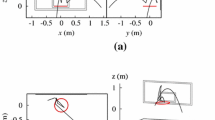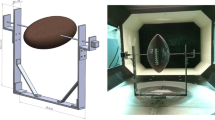Abstract
The fourth-order Runge–Kutta method is used to numerically integrate the equations of motion for a fastpitch softball pitch and to create a model from which the trajectories of drop balls, rise balls and curve balls can be computed and displayed. By requiring these pitches to pass through the strike zone, and by assuming specific values for the initial speed, launch angle and height of each pitch, an upper limit on the lift coefficient can be predicted which agrees with experimental data. This approach also predicts the launch angles necessary to put rise balls, drop balls and curve balls in the strike zone, as well as a value of the drag coefficient that agrees with experimental data. Finally, Adair’s analysis of a batter’s swing is used to compare pitches that look similar to a batter starting her swing, yet which diverge before reaching the home plate, to predict when she is likely to miss or foul the ball.





Similar content being viewed by others
References
Frohlich C (2011) Resource Letter-PS2: The Physics of Sports. Am J Phys 79:565–574
Cross R (2011) The Physics of Baseball and Softball. Springer, New York
Nathan AM The Physics of Baseball: Fastpitch Softball Research. http://baseball.physics.illinois.edu/softball.html. Accessed 24 Apr 2015
Adair RK (2002) The Physics of Baseball, 3rd edn. IT Books/Harper-Collins, New York
Arnold D Spherical Coordinates in Matlab. http://msemac.redwoods.edu/~darnold/math50c/mathjax/spherical/index.xhtml. Accessed 24 Apr 2015
Nathan AM (2008) The effect of spin on the flight of a baseball. Am J Phys 76:119–124
Air—Temperature, Pressure and Density. The Engineering ToolBox. http://www.engineeringtoolbox.com/air-temperature-pressure-density-d_771.html. Accessed 24 Apr 2015
Abrahamson D (2013) NCAA Softball: 2014 and 2015 Rules and Interpretations. http://www.ncaapublications.com/p-4319-2014-and-2015-softball-rules.aspx. Accessed 2 Feb 2015
What’s the Average Pitch Speed. Mize Fastpitch Diamonds. http://www.mizefastpitchdiamonds.com/news_article/show/9307?referrer_id=30863-news. Accessed 24 Apr 2015
Sawicki GS, Hubbard M, Stronge WJ (2003) How to hit home runs: optimum baseball bat swing parameters for maximum range trajectories. Am J Phys 71:1152–1162
Watts RG, Ferrer R (1987) The lateral force on a spinning sphere: aerodynamics of a curveball. Am J Phys 55:40–44
Alaways LW, Hubbard M (2001) Experimental determination of baseball spin and lift. J Sport Sci 19:349–358
Cross R (2012) Aerodynamics in the classroom and at the ball park. Am J Phys 80:289–297
Spin Rate Data. RevFire. http://www.revfire.com/coaching_data.html. Accessed 24 Apr 2015
FAQ. RevFire. http://www.revfire.com/faq.html. Accessed 24 Apr 2015
Fastpitch Softball Spin Rate Guide. RevFire. http://www.revfire.com/files/Spin_Rate_Guide_-_SBO_v7. Accessed 24 Apr 2015
Acknowledgments
We thank Professor Alan Nathan of the University of Illinois at Urbana-Champaign, who read an earlier version of this manuscript and made many helpful suggestions. We also thank Professor Gwen Lexow, former Head Softball Coach at Bates College, for her insights into pitching.
Author information
Authors and Affiliations
Corresponding author
Rights and permissions
About this article
Cite this article
Clark, J.M., Greer, M.L. & Semon, M.D. Modeling pitch trajectories in fastpitch softball. Sports Eng 18, 157–164 (2015). https://doi.org/10.1007/s12283-015-0176-4
Published:
Issue Date:
DOI: https://doi.org/10.1007/s12283-015-0176-4




